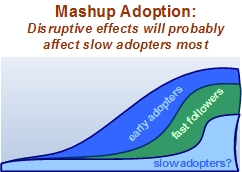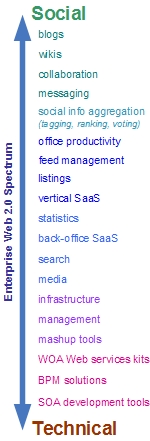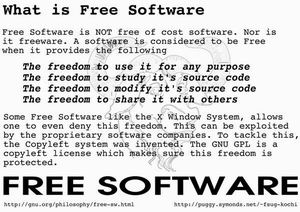Difference between revisions of "Scenario 1: Mashup Mania"
| Line 9: | Line 9: | ||
The tenets of Web 2.0 can be exhibited in a variety of ways that range across a spectrum with social aspects at one end to primarily technical ones at the other (figure below). Mashup software for the enterprise can effectively demonstrate aspects across part of this range, most of it, or just a snippet of it. But the generally, '''the idea of mashup mania scenario is that mashup software together with Web 2.0 is online, open, made of pieces, encourages constructive social interaction, and is driven slightly more by its users and data than specific features.''' Wikis are a great example of this latter concept; their biggest two features are the edit and save buttons, with the data and people gathering there being far more important." | The tenets of Web 2.0 can be exhibited in a variety of ways that range across a spectrum with social aspects at one end to primarily technical ones at the other (figure below). Mashup software for the enterprise can effectively demonstrate aspects across part of this range, most of it, or just a snippet of it. But the generally, '''the idea of mashup mania scenario is that mashup software together with Web 2.0 is online, open, made of pieces, encourages constructive social interaction, and is driven slightly more by its users and data than specific features.''' Wikis are a great example of this latter concept; their biggest two features are the edit and save buttons, with the data and people gathering there being far more important." | ||
[[Image:web20spectrum.jpg]] | |||
'''Mashups in the Enterprise''' | '''Mashups in the Enterprise''' | ||
| Line 38: | Line 41: | ||
'''Security (The cross-domain security problem)''' | '''Security (The cross-domain security problem)''' | ||
A real issue with many mashups is that they want to combine the data from Web services from over the Web. Ironically, at this point in time, the browser security sandbox really discourages this. In reality, many mashups do the mashup part on the server because of this restriction. Using the Web as a world-wide SOA isn't going to happen until this problem is solved. The sandbox can be worked around with quite a bit of effort today but there needs to be a one-size fits all browser solution. In mashup mania scenario, big players in browser industry work together (Microsoft, Mozilla, Apple, etc.). | A real issue with many mashups is that they want to combine the data from Web services from over the Web. Ironically, at this point in time, the browser security sandbox really discourages this. In reality, many mashups do the mashup part on the server because of this restriction. Using the Web as a world-wide SOA isn't going to happen until this problem is solved. The sandbox can be worked around with quite a bit of effort today but there needs to be a one-size fits all browser solution. In mashup mania scenario, big players in browser industry work together (Microsoft, Mozilla, Apple, etc.). | ||
Revision as of 22:26, 6 June 2006
Culture Mashup adoption follows the usual curve. Enthusiasts first, then early adopters, then fast followers, and finally, after it's been happening so long its old news, slow adopters. Mashups, like Ajax, are a disruptive technology, meaning that they are a genuine threat to the old way of doing things. The old way here being traditional EAI and composite application technology from SOAs. In mashup mania scenario, this may very well mean that slow adopters are the never adopters, because they're cancelled, put to pasture, given special projects, or what-have-you. Fast-moving folks with good mashup tools and a vast landscape of services can punch out 10 smaller applications that not only do what your old creaky ways of building software did, but are in turn reusable and composable.
The tenets of Web 2.0 can be exhibited in a variety of ways that range across a spectrum with social aspects at one end to primarily technical ones at the other (figure below). Mashup software for the enterprise can effectively demonstrate aspects across part of this range, most of it, or just a snippet of it. But the generally, the idea of mashup mania scenario is that mashup software together with Web 2.0 is online, open, made of pieces, encourages constructive social interaction, and is driven slightly more by its users and data than specific features. Wikis are a great example of this latter concept; their biggest two features are the edit and save buttons, with the data and people gathering there being far more important."
Mashups in the Enterprise
In mashup mania scenario, there are two central themes to mashups and Web 2.0 -- user/community collaboration and rapid application development and integration. Both face challenges from Enterprise IT, but both are inevitably part of the Enterprise Software stack.
Big Enterprise 2.0 In many ways the penetration of “Mashup-like” technologies are easy. A large part of Enterprise IT’s budget is spent on application integration. The challenge for Mashup techniques will be the balance between ease of use and sophistication. Arguably Microsoft Office enables desktop mashups today – access multiple information sources with Excel and Access and render new dynamic reports in Word. But this isn’t easy enough for most users, robust enough for mission critical IT, nor secure enough to place in the cloud for universal access. Yet the latent demand for a ‘long tail’ of user applications remains. Mashup technologies are the response to empowering end users to create Web 2.0 solutions.
The big influence of Web 2.0 on Enterprise apps don’t look like a Flickr, Mappr, Taggr, or Tiggr behind a firewall. They don’t look like a wiki, digg, or a space. Collaboration is a feature, not a purpose. Many, if not all, Enterprise applications include tagging, collaborative markup, etc. But collaboration becomes a feature of business process applications the way printing is feature of desktop applications.
Many Enterprise applications in the Enterprise are not in the Enterprise at all. Users collaborate in the cloud, not in the desk. Think “expense tracking and reporting”, “personnel reviews”, “sales force collaboration,” and all the other micro processes that plague every enterprise, big and small. By definition, as we work on the road, from home, or on our Blackberries, we remain part of these long running processes that reach outside the firewall.
New business user definition
Enterprise mashup, requires a special kind of business user: a knowledge worker who is adept at leveraging the power of SOBAs to meet ever-changing business needs. Indeed, while some knowledge workers have the technical capabilities necessary to construct today's mashups, the true promise of SOBAs depends upon user interfaces sophisticated enough for a broader business audience to use. Fortunately, enterprises already have knowledge workers at this level: people who are proficient with Microsoft Excel. Not only does Excel make a powerful SOBA consumer in its own right, but the technical skill people need to get value out of an application like Excel is the level SOBA tools vendors should target when building SOBA interface applications. Few such tools exist today, but the writing is on the wall: the enterprise mashup is the future of the SOBA consumer.
In mashup mania scenario, enterprise mashups enables the business users getting the direct control over the business processes and business rules that govern how enterprise applications behave. Business units are dominated by business users possessing analytical and conceptual thinking skills. The new breed of business users are capable of engineering their business, they can easily assemble, tailor, change and maintain enterprise mashups. The number of employees in traditional IT departments decrease, and even internal IT departments are closed off, instead, traditional function of IT departments spread throughout the organization.
Transactional mashups In this scenario, there are more examples of 'transactional' mashups - i.e. full-fledged web applications in which users can not only view (read) mashed up data, but do transactions with that data within the mashup.
Taking the "eBay Motors" as an example, users can actually complete the purchase of a car from within the mashup itself - instead of being directed to the eBay website. The value would remain the same for eBay, who get the same cut of the action. Indeed eBay finds purchases increase, because the user can do everything from the one place (the mashup site). It would almost certainly mean more value for the mashup, because users would be able to do more things on the mashup site - which gives more monetization opportunities (e.g. advertising).
Standardization & API A real universal registry for mashup APIs gets figured out. Sites likes Programmable Web do an amazing job making it easy to find the API you're looking for. But this is a far cry from the formalism of UDDI, the Web services directory standard. This means sorting through APIs is done manually and is not tool aided. In this scenario this situation doesn't last long. Very new releases, upgrades to UDDI 3.0 includes the trick. We've only seen Ajax applications and reusable APIs proliferate like this for about a year. It’s expected in this scenario to see APIs and services sprout up like wildflowers inside and outside the firewall and it will be so very tempting to use them.
Security (The cross-domain security problem) A real issue with many mashups is that they want to combine the data from Web services from over the Web. Ironically, at this point in time, the browser security sandbox really discourages this. In reality, many mashups do the mashup part on the server because of this restriction. Using the Web as a world-wide SOA isn't going to happen until this problem is solved. The sandbox can be worked around with quite a bit of effort today but there needs to be a one-size fits all browser solution. In mashup mania scenario, big players in browser industry work together (Microsoft, Mozilla, Apple, etc.).
Copyright
In 1960s and 1970s, software was seen as an add-on supplied by mainframe vendors to make computers useful. Late 1970s and early 1980s companies began routinely imposing restrictions on programmers with software license agreements. Sometimes this was because companies were now making money from proprietary software or they were trying to keep hardware characteristics secret by hiding the source code. Other times it was because of the increasingly corporatised attitude in the growing and previously eclectic industry saw protecting source code and trade secrets as a norm even if it didn't provide any benefit to business. 1983 Richard Stallman launched the GNU project after becoming frustrated with the effects of the change in culture of the computer industry and users. One incident was when a printer wouldn't work but he couldn't hack the source code to fix the problem because it was withheld. Software development for the GNU operating system began in January 1984, and Free Software Foundation (FSF) was founded in October 1985. He introduced a free software definition and "copyleft", designed to ensure software freedom for all. At present day free software is a huge international effort, producing software used by individuals, large organisations, and even entire countries. The economic advantages of the free software model, and, to a lesser extent, the ethical principles that it was founded upon are beginning to be recognised, even by mainstream media. Also, some other industries — that is, non-software industries — are beginning to recognise the value of free software's message too: scientists, for example, are looking towards more open development processes, and hardware such as microchips is beginning to be developed under Copyleft licenses (the OpenCores project, for instance). The Creative Commons and Open Content movements have also been largely influenced by free software.
In the Mashup mania future, the future step of the copyright evolution the software industry returns to be about a free exchange of ideas and code. Lengthy, but temporary period during which software was a proprietary, closed science is responded. The consequences of that process produced bad software at high prices, and the situation is reversed. People think well and share
Major software vendors copied the innovation of individual software developers to make a profit at the expense of users. The environment is changed to make their business model impossible, sharing produces better technology at lower prices and enables people to succeed in all sorts of social and economic endeavors.



